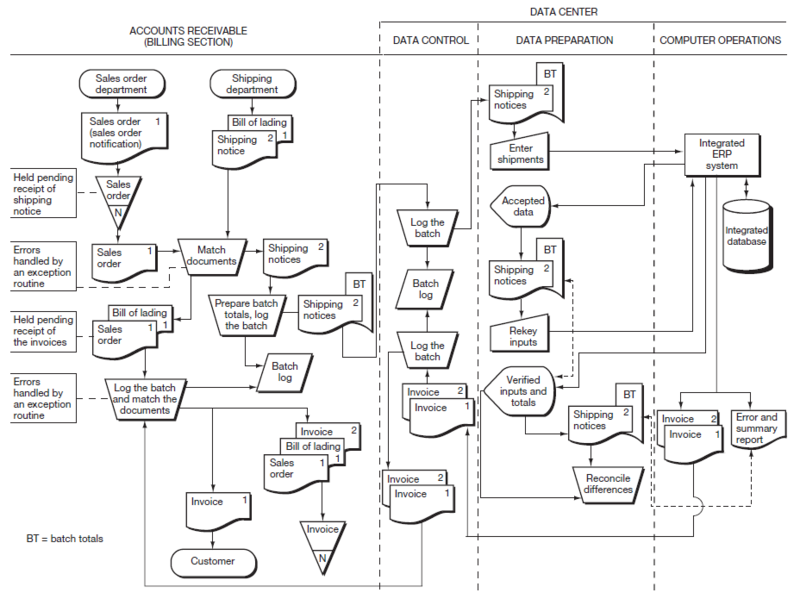At the time the sales order documents were prepared in the order entry department, copy 1 was sent to the billing department (the annotation to the left of the sales order data indicates that these “sales order notifications” are held pending receipt of the shipping notices). At the end of each day, billing receives (from the shipping department) batches of bills of lading (copy 1), accompanied by shipping notices (sales order copy 2).
In the billing department, a clerk compares the details of these documents. Data that fail to pass the document-matching control are removed from the batch; these data are handled by a separate exception routine. Corrected data will be submitted to the computer during a subsequent processing cycle.
If there is agreement among the data items, the billing clerk prepares batch totals, logs each batch, and sends the batches to data control. Data control logs the batches and forwards them to data preparation. Data preparation clerks records the shipping notices to the sales event database. A second clerk reenters the inputs. After reconciliation of any differences between the manually calculated batch totals and the batch totals calculated by the program, the sales data are forwarded to computer operations. This concludes the recording process.
The first step of the update process is to sort and merge sales data in order to prepare the data for sequential processing against the accounts receivable master data. A maintenance run brings the master data up to date and prints one or more reports. Any errors discovered during the process run are recorded with the error suspense data along with a record of each sales order (i.e., shipping notice) number processed during the run.
Output invoices are sent back to data control to be logged out and then are sent to the billing department. Once the invoices have been received by the billing department, a clerk logs the batch back in and matches the invoices with the sales orders and bills of lading. If the documents match, the original invoice is sent to the customer, and the copy is filed with the sales order and bill of lading.
Once you have had the opportunity to study the billing process documented in Figure 12.6, stop and consider how this might change in an enterprise system environment. After you have thought through the impact and the resulting changes to Figure 12.6, read Technology Insight 11.3, which provides an overview of how a fully implemented enterprise system impacts the billing process discussed in this chapter.
TECHNOLOGY INSIGHT 11.3
Enterprise System Support for the Billing Process
The main effect of the introduction of an enterprise system into the billing process depicted in Figure 12.6 is the integration of the processing programs and the various data stores into a single unified processing system with a single underlying database. In terms of the diagrams, the primary impact is therefore on the activities depicted within the “data center.” These changes are demonstrated in the diagram. Note that the systems flowchart has significantly simplified, but the consolidation of all of the processes and databases shown in Figure 12.6 to the single process and database in the figure is indicative of the complexity within an enterprise system. You should also recognize that for clarity and comparability the diagram shows the use of batch totals and batch comparisons. In many enterprise-wide environments, traditional batch control procedures as depicted might not be retained, depending on how much the organization decides to change its business processes upon implementation of the enterprise system.

- 5397 reads






